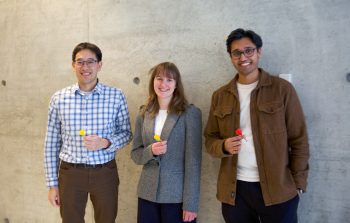Originally published in the Spring 2015 issue of Edge Magazine.
According to recent studies, texting while driving has surpassed drunkenness as the leading cause of death for teen drivers. But even as public service campaigns plead with drivers to relinquish their devices, cars are increasingly loaded up with GPSs, infotainment systems, dash cams and other on-board tech.
Cars themselves are becoming devices of distraction.
As vehicles get brainier, auto manufacturers have turned to university researchers to find ways to reduce, rather than exacerbate, distracted driving. Counterintuitively, that can mean turning driving into a kind of game.
“If your eyes have been off the road for a certain number of seconds, we’re going to provide you with real-time warnings. We know that helps,” says Birsen Donmez (MIE), an assistant professor in the Department of Mechanical & Industrial Engineering who researches human-car interactions. “But we’re also experimenting with a gamification interface to motivate drivers to decrease their distraction.”
Using eye tracking, proximity sensors and other measurements, her lab generates post-trip reports on a driver’s performance. Drivers can compare their records against those of their peers or general society to see how they stack up — turning safe driving into a competitive sport.
“We also try to give people badges like in a game,” Donmez says. “‘In this portion of the drive, you were safe, your driving performance was good.’ This may help change the intrinsic motivation of the driver.”
She has been running tests both in simulators and on the road. Toyota Canada donated a Rav 4 to the project, which Birsen’s lab is tricking out with sensors and data recorders. The car manufacturer also supports her research financially through the Toyota Collaborative Safety Research Center (CSRC). Reflecting the complexity of modern car-making, the CSRC supports research that explores major issues like safety, rather than focusing on developing a specific new widget. Manufacturers like Toyota have begun to recognize the value in supporting research whose outcome is not known.
“Dr. Donmez’s research could eventually find its way into production,” says James Foley, the senior principal engineer at CSRC. “Once the project is completed and we know the benefits it can offer to encourage safe driving and minimize driver distraction, Toyota can consider how to best incorporate them into a car.”
Donmez says the game elements of her research will likely be most effective with risk-unaware or non-risk-averse drivers. (That’s code for teenagers.) Real-time warnings may matter more to older drivers who have declines in their attentional abilities.
Of course, she is wary of designing a feedback system that becomes a distraction unto itself.
“With something like a single alert that comes up if your eyes are off the road, the meaning is clear,” she says. “But with more complex displays we want to ensure that people’s eyes aren’t off the road for more than two seconds.”
Donmez’s partnership with Toyota concludes later this year, but the CSRC has announced a new round of funding. Her lab is in contention for follow-up projects, also aimed at ensuring that cars’ brains don’t mess up the brains of their drivers.



